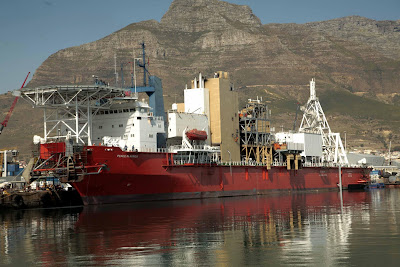A brand new international TV series, Mighty Ships starts this evening at 20:00 on Discovery Channel (DStv 121) featuring a South Afric vessel, the MV Peace in Africa in the debut episode.
The massive ship is the most modern diamond mining vessel in the world and in tonight's first episode of Mighty Ships viewers will get the first-ever look at life on board, how the ship looks, and what it does as it mines for diamonds on South Africa's treacherous West Coast. I spoke to Elizly Steyn, production metallurgist onboard the Peace in Africa by satellite video call and asked her some questions.
For the Q&A and some more information about the Peace in Africa, as well as photos and awesome facts, click on READ MORE below.
The Peace in Africa was built at a cost of $15 million at the A&P Tyne shipyard in Newcastle. The Peace in Africa stays out at sea for two and a half years with a crew of 60 people working 12 hour shifts (the crew changes monthly, ever 28 days). The Peace in Africa is the most advanced diamond mining vessel in the world.
Viewers will get a very clear picture of what exactly we do from the gravel that is on the seabed, all the way to the sorting area and until it's ready to be sold. We have high security onboard in certain areas and that is very clearly stated in the documentary and viewers will see that. We did allow them a sortof carte blanche so that they can get an idea of how the process runs, but there's a lot of – especially in the high security areas – where we didn't allow them to film the entire area, but rather focused on the processes.
Do the Peace in Africa after it has mined a certain area of the sea bed ever go over it again?
What we do is we have quite a detailed plan of what we expect. When we don't get what we expect, we do what we call ''audit mining''. We use the drill technology and we identify a certain area and we audit the area to see if we made a mistake upfront, if we have a processing efficiency issue, so that's the only time we go over it again. The idea is to optimize the mining efficiency upfront because the intention is not to return. Ideally you go in, mine once-off and the area is left to recover.
What is the lifetime of the ship, how long will you guys use the Peace in Africa for?
Every two and a half years the ship comes in for major work. So you can continue to use the vessel as long as you are prepared to spend the financial resources in keeping her safe.
What do you guys do in storms, can you still continue mining and be operational?
We have a compensation system that allows us to continue mining in swells of up to 10 metres, so you can have a vertical movement on the ship of up to 10 metres. We've got some big thrusters installed on the vessel that allows us to relieve the pressure on the mooring systems.
What kind of stuff breaks the most and where do you have the most wear and tear - not necessarily the drills? What's the maintenance plan on the Peace in Africa?
The crawler is quite a challenge. It's quite a mission keeping that machine running. It's got a lot of electronics onboard and that electronics require a lot of sensors to measure everything that is happening on the seabed. If we don't get that feedback, it affects our total mining operation. From an electronics side we have quite a challenge. But we still maintain around 72% utilization and that's a world class standard. The other big area is wear. We're pumping a very coarse material and it wears down the liners. We have one inch thick liners as we pump the rock to the surface and that takes quite a beating. We have to replace that regularly. The crawler is programmed to come up every six days and can spend anything from 8 to 12 hours maintaining it with a team on the vessel.
Obviously it's not a five star hotel but can you tell me what you guys get to eat and what the diet and food is on the Peace in Africa?
If you walk around on the ship you'll see a whole bunch of really big people and really small people and really healthy people. Accomodation onboard for me is really comfortable. It's neat and clean, it is like staying in a hotel - the only difference is that you're staying out at sea. Food wise we have a team who's only focus is on making really good food. You can eat very oily, or you can eat salads and very healthy. We have breakfast, lunch and dinner on the Peace in Africa. There's food here for everyone and all diets. We're really treated very well in that respect.
What is the running cost of the Peace in Africa per month?
R20 million per month just direct operating cost.
Mighty Ships, Tuesday, 4 May, Discovery Channel (DStv 121), 20:00
Note: Discovery Channel (DStv 121) has a one hour TV show, Mondays to Fridays from 20:00 during May as part of the TV channel's ''Big Stuff Month'', of which Mighty Ships is one series. Others include Huge Moves and The World's Biggest Tools.




